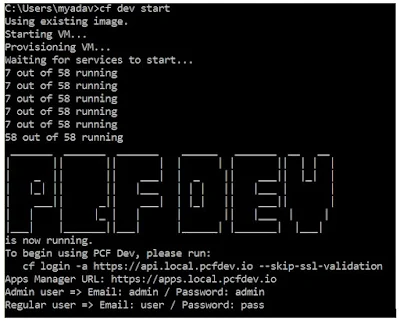In this blog I will introduce you to Pivotal Cloud Foundry (PCF), provide you instructions on how to setup PCF Laptop Lab to play around and finally discuss best practices to be used for Enterprise PCF Deployment. So, lets start with Introduction PCF.
PCF in Nutshell
PCF is enterprise grade Cloud Foundry which is Open Source software. As described in following diagram, traditionally we used to manage the entire IT stack from top to bottom, as we evolve into Private cloud, we started offering IaaS and PaaS services. So PCF is essentially PaaS offering which is enterprise grade and runs on Any IaaS, well most of the leading IaaS !
Lets look at very high level what's in it. In following diagram, I have tried to explain PCF from 2 angles, Infrastructure and Operations.
The biggest advantage of PCF is Rapid Application deployment and scaling, we just need 2 command to deploy and scale applications in PCF!
PCF Laptop Lab
Best practices for Enterprise PCF deployments
... Will keep updating this section.
PCF in Nutshell
PCF is enterprise grade Cloud Foundry which is Open Source software. As described in following diagram, traditionally we used to manage the entire IT stack from top to bottom, as we evolve into Private cloud, we started offering IaaS and PaaS services. So PCF is essentially PaaS offering which is enterprise grade and runs on Any IaaS, well most of the leading IaaS !
Lets look at very high level what's in it. In following diagram, I have tried to explain PCF from 2 angles, Infrastructure and Operations.
The biggest advantage of PCF is Rapid Application deployment and scaling, we just need 2 command to deploy and scale applications in PCF!
PCF Laptop Lab
Login to pivotal site create an account and create a org.
Make sure that you have at least 40 GB free disk space and 5 GB free RAM
Download and install virtual box
Download and install JDK 1.8.X
Download CF CLI tool
Check the installation using following command
cf help
Download and install the pcfdev, unzip the downloaded file and run the exe.
Start the Dev PCF (This may take several min’s depending
on your internet speed)
cf dev start
Once started, deploy sample spring music application.
unzip the above file.
cd spring-music-master
.\gradlew.bat assemble
Deploy the Application
cf login -a https://api.local.pcfdev.io
--skip-ssl-validation
admin/admin
cf push --hostname spring-music
Login to Admin console and verify application is up and running
https://apps.local.pcfdev.io admin/admin
Check out the sample app
Here are few other useful commands
Viewing logs
cf logs spring-music --recent
cf logs spring-music
Install database and connect
cf marketplace -s p-mysql
cf create-service p-mysql 512mb my-spring-db
cf bind-service spring-music my-spring-db
Restart services
cf restart spring-music
cf services
Scale applications
cf scale spring-music -i 2
cf app spring-music
state since cpu memory disk details
#0 running 2017-10-22T07:13:43Z 0.3%
380.9M of 1G 170.1M of 512M
#1 starting 2017-10-22T07:18:03Z 52.9%
249.1M of 1G 170M of 512M
Increase the resources of app
cf scale spring-music -m 1G
cf scale spring-music -k 512M
Best practices for Enterprise PCF deployments
- Size your PFC using PCF sizing tool
- Store all the passwords in keypass
- Make sure that you setup at least 3 Availability Zones
- Plan and design your Org, Spaces, Apps and Security of Applications well in advance before you start the setup
... Will keep updating this section.











